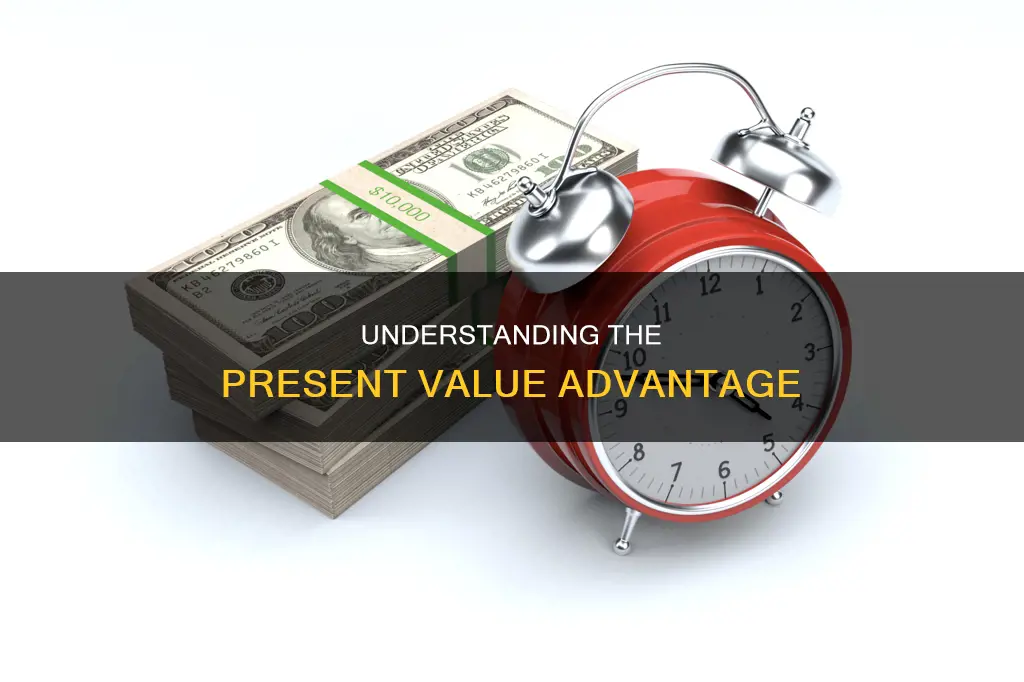
Present value (PV) is a concept in finance and economics that refers to the current value of a future sum of money or expected income stream. It is calculated by discounting the future value or expected income at a specified rate of return, often referred to as the discount rate. This calculation takes into account the time value of money, which suggests that a dollar today is worth more than a dollar tomorrow because of its potential to earn interest over time.
Present value is important for investors and businesses when evaluating potential investments or projects. It helps determine if an investment is worth pursuing by estimating its rate of return and comparing it to other investment opportunities. By calculating the present value, investors can make more informed decisions about where to allocate their capital to maximise returns.
| Characteristics | Values |
|---|---|
| Definition | Present value (PV) is the current value of a future sum of money or stream of cash flows |
| Calculation | PV = Future Value / (1+i)^n |
| Use | PV calculations can be useful in investing and in strategic planning for businesses |
| Importance | PV allows investors and businesses to judge whether a future outcome will be worth making the investment today |
| Compared to Future Value | PV is usually less than the future value because money has interest-earning potential |
| Compared to Net Present Value | PV is usually associated with learning broad financial concepts and financial calculators, while NPV is a common metric used in financial analysis and accounting |
What You'll Learn
- Present value is the current value of a future sum of money
- It is used to calculate the value of loans, mortgages, annuities, sinking funds, and more
- It is based on the concept that a sum of money today is likely to be worth more than the same sum in the future
- Present value calculations require an estimate of the potential rate of return, known as the discount rate
- Present value can be used to decide between competing investments

Present value is the current value of a future sum of money
Present value, also known as present discounted value, is the current value of a future sum of money. It is the value of an expected income stream determined as of the date of valuation.
The concept of present value is based on the idea that money in hand today is worth more than the same amount in the future because it can be invested and earn a return. This is known as the time value of money. For example, $1000 today is worth more than $1000 in five years because the $1000 can be invested and earn a return over those five years.
The present value of a future sum of money is calculated by discounting the future value by the estimated rate of return that the money could earn if invested. This estimated rate of return is known as the discount rate. The higher the discount rate, the lower the present value, as a higher rate of return is assumed.
Present value calculations are useful in investing and strategic planning for businesses. They can help investors and businesses decide whether an investment is worth pursuing and in choosing among potential investments. Present value calculations can also be used to value loans, mortgages, annuities, and bonds, among other things.
Merck: A Worthy Investment?
You may want to see also

It is used to calculate the value of loans, mortgages, annuities, sinking funds, and more
Present value (PV) is a critical concept in finance, forming the basis of mortgages, loans, and credit cards. It is the current value of a future sum of money or stream of cash flows. In other words, it is the value today of a sum of money to be received in the future.
Calculating the present value of a future sum of money involves discounting the future value by the estimated rate of return that the money could earn if invested. This rate of return is known as the discount rate. The present value of a future sum can be calculated using the following formula:
Present Value = Future Value / (1 + rate of return)number of periods
For example, if you are due to receive $1,000 in five years, what is that sum worth to you today? Assuming a 5% interest rate compounded annually, the present value of that sum is $784.
The present value of periodical deposits or annuity payments can also be calculated. An annuity is a series of recurring payments, such as rent or interest on a bond, that are made at the end of each period (ordinary annuity) or the beginning of each period (annuity due). The present value of an ordinary annuity can be calculated using the following formula:
Present Valueordinary annuity = cash flow per period x [1 - (1 + interest rate)-number of payments] / interest rate
For example, if you invest $1,000 every year for five years at 5% interest, you will have a total of $5,525.63 at the end of the five-year period. To calculate the present value of these payments, you can use the formula:
Present Valueordinary annuity = $1,000 x [1 - (1 + 0.05)-5] / 0.05 = $4,329.48
The present value of an annuity due can be calculated using a similar formula, adjusted to account for payments made at the beginning of each period:
Present Valueannuity due = cash flow per period x [1 - (1 + interest rate)-number of payments] / interest rate x (1 + interest rate)
For instance, if you pay $1,000 in rent every month for the next five months, and this money earns 5% interest, the present value of these payments is $4,545.95.
Present value calculations are also used in capital budgeting and investment planning to analyze the profitability of a projected investment or project. This is known as net present value (NPV). NPV is the difference between the present value of cash inflows and the present value of cash outflows over a period of time. A positive NPV indicates that the projected earnings from an investment exceed the anticipated costs, making it a profitable venture.
Young Investors: Where to Begin?
You may want to see also

It is based on the concept that a sum of money today is likely to be worth more than the same sum in the future
The concept of time value of money (TVM) is a basic principle in the world of finance and investment. It is the idea that money available at the present time is worth more than the same amount in the future. This is due to two main reasons: inflation and opportunity cost.
Firstly, inflation refers to the gradual increase in the prices of goods and services over time. As a result, the purchasing power of money decreases, and a dollar today will buy fewer goods and services in the future due to inflation. This means that a dollar today is worth more in terms of what it can buy compared to the same amount in the future.
Secondly, opportunity cost refers to the benefits forgone when choosing one alternative over another. In the context of TVM, the opportunity cost is the potential to earn interest or invest money for growth. Money received today can be invested or saved to grow over time, making it more valuable than the same amount received later. This is because the core principle of finance assumes that any amount of money received sooner is worth more than the same amount received later, as it has the potential to generate additional value through interest or investments.
For example, let's consider a scenario where you have the option to receive $2,000 today or $2,200 one year from now. If you choose to receive the money today, you could invest it and earn interest on it. Assuming a 3% interest rate, the $2,000 would grow to $2,060 in one year. Therefore, if you were to choose to receive the money one year from now, you would need to receive at least $2,060 to have the same value as $2,000 today. This illustrates the concept that a sum of money today is likely to be worth more than the same sum in the future due to its potential earning capacity.
In conclusion, the time value of money is a critical concept in finance and investment, and it underscores the importance of making timely and prudent financial decisions. It highlights that a dollar today is not just a dollar but a potential source of future wealth, while a dollar in the future represents a missed opportunity to invest and grow that money.
American Eagle Inc: A Smart Investment Move
You may want to see also

Present value calculations require an estimate of the potential rate of return, known as the discount rate
Present value (PV) is the current value of a future sum of money or a stream of cash flows. It is determined by discounting the future value by the estimated rate of return that the money could earn if it were invested. Present value calculations are useful for investors and businesses making strategic plans.
The concept of present value is based on the idea that a sum of money today is likely to be worth more than the same sum in the future because it can be invested and earn a return in the meantime. Present value calculations require an estimate of that potential rate of return, known as the discount rate. The discount rate is an estimate of the return that could be earned if the same amount of money were invested for the same period.
The discount rate is highly subjective because it is based on an estimate of the rate of return that could be earned on an investment with a similar risk profile over the same period. The discount rate can be calculated using the following formula:
> Discount Rate = (Future Value ÷ Present Value)^(1 ÷ n) – 1
In this formula, "n" is the number of years. The discount rate is critical in a discounted cash flow (DCF) analysis, which is used to determine the intrinsic value of an investment based on its projected cash flows.
The selection of the discount rate depends on the stakeholders being represented:
- Weighted Average Cost of Capital (WACC) is used for all stakeholders (debt and equity holders).
- Cost of Equity is used for common shareholders.
- Cost of Debt is used for debt lenders.
- Cost of Preferred Stock is used for preferred stockholders.
The accuracy of present value calculations depends on the accuracy of the discount rate. If the discount rate is inaccurate, the present value calculation will also be inaccurate. A higher discount rate will result in a lower present value, as it assumes a higher return on the money.
VC Bias: Do Looks Matter?
You may want to see also

Present value can be used to decide between competing investments
Present value (PV) is the current value of a future sum of money or stream of cash flows. It is determined by discounting the future value by the estimated rate of return that the money could earn if invested. Present value calculations can be useful in investing and in strategic planning for businesses.
Present value calculations require an estimate of the potential rate of return, known as the discount rate. The discount rate is the rate of return used in the present value calculation and represents the forgone rate of return if you chose to accept a sum of money in the future versus the same amount today.
The present value can be calculated using the following formula:
Present Value = Future Value / (1 + rate of return)^number of periods
Where:
- Future Value = the expected future value of the investment
- Rate of return = the estimated interest rate that the money could earn if invested
- Number of periods = the time period over which the investment is made
Present value calculations can be useful for investors and companies in deciding between competing investments. By calculating the present value of different investment options, investors can compare the potential returns and make more informed decisions.
For example, consider an investor who has the option to invest in two different projects with the following cash flows:
Project A:
- Initial investment: $15 million
- Cash Flow Year 1: $3 million
- Cash Flow Year 2: $3 million
- Cash Flow Year 3: $5 million
- Cash Flow Year 4: $5 million
- Cash Flow Year 5: $5 million
Project B:
- Initial investment: $20 million
- Cash Flow Year 1: $2 million
- Cash Flow Year 2: $4 million
- Cash Flow Year 3: $6 million
- Cash Flow Year 4: $8 million
- Cash Flow Year 5: $10 million
Assuming a discount rate of 7% for both projects, the net present value (NPV) can be calculated as follows:
Project A:
- Annual discounted cash flows: $3,000,000 / (1.07)^1 + $3,000,000 / (1.07)^2 + $5,000,000 / (1.07)^3 + $5,000,000 / (1.07)^4 + $5,000,000 / (1.07)^5 = $16,884,950
- NPV = $16,884,950 - $15,000,000 = $1,884,950
Project B:
- Annual discounted cash flows: $2,000,000 / (1.07)^1 + $4,000,000 / (1.07)^2 + $6,000,000 / (1.07)^3 + $8,000,000 / (1.07)^4 + $10,000,000 / (1.07)^5 = $23,493,725
- NPV = $23,493,725 - $20,000,000 = $3,493,725
Based on the NPV calculations, Project B appears to be the more profitable investment option, with a higher NPV. However, it's important to consider other factors as well, such as the initial investment required and the potential intangible benefits of each project.
Luna: The People's Crypto
You may want to see also
Frequently asked questions
Present value (PV) is the current value of a future sum of money or stream of cash flows. It is determined by discounting the future value by the estimated rate of return that the money could earn if invested.
The formula for calculating the present value is:
Present Value = Future Value / (1+i)n
Where:
- Future Value = the expected future value of the investment
- i = the expected rate of return on the investment
- n = the number of periods the investment will be held for
The present value is the value of a sum of money today, taking into account the time value of money and the expected rate of return. The future value is the value of a sum of money at a future date, assuming compound interest.
Present value is used to compare the relative value of different investment options. By calculating the present value of each investment, investors can determine which option provides the highest value for the lowest initial outlay.







